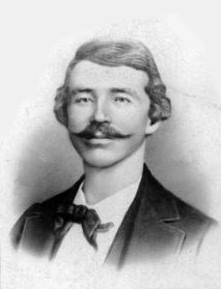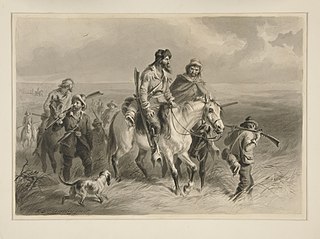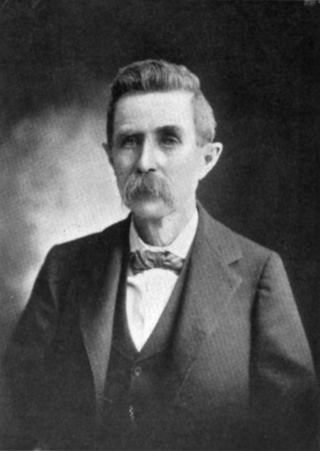
Oswego is a city in and the county seat of Labette County, Kansas, United States, and situated along the Neosho River. As of the 2020 census, the population of the city was 1,668.

St. Paul or Saint Paul is a city in Neosho County, Kansas, United States. As of the 2020 census, the population of the city was 614.

Bleeding Kansas, Bloody Kansas, or the Border War was a series of violent civil confrontations in Kansas Territory, and to a lesser extent in western Missouri, between 1854 and 1859. It emerged from a political and ideological debate over the legality of slavery in the proposed state of Kansas.

William Clarke Quantrill was a Confederate guerrilla leader and mass murderer during the American Civil War.

Brigadier-General Stand Watie, also known as Standhope Uwatie and Isaac S. Watie, was a Cherokee politician who served as the second principal chief of the Cherokee Nation from 1862 to 1866. The Cherokee Nation allied with the Confederate States during the American Civil War and he was the only Native American Confederate general officer of the war. Watie commanded Indian forces in the Trans-Mississippi Theater, made up mostly of Cherokee, Muskogee, and Seminole. He was the last Confederate States Army general to surrender.

Border ruffians were proslavery raiders who crossed into the Kansas Territory from Missouri during the mid-19th century to help ensure the territory entered the United States as a slave state. Their activities formed a major part of a series of violent civil confrontations known as "Bleeding Kansas", which peaked from 1854 to 1858. Crimes committed by border ruffians included electoral fraud, intimidation, assault, property damage and murder; many border ruffians took pride in their reputation as criminals. After the outbreak of the American Civil War in 1861, many border ruffians fought on the side of the Confederate States of America as irregular bushwhackers.

The Osage Nation is a Midwestern American tribe of the Great Plains. The tribe developed in the Ohio and Mississippi river valleys around 700 B.C. along with other groups of its language family. They migrated west after the 17th century, settling near the confluence of the Missouri and Mississippi rivers, as a result of Iroquois expansion into the Ohio Country in the aftermath of the Beaver Wars.

James G.Blunt was an American physician and abolitionist who rose to the rank of major general in the Union Army during the American Civil War. He was defeated by Quantrill's Raiders at the Battle of Baxter Springs in Kansas in 1863, but is considered to have served well the next year as a division commander during Price's Raid in Missouri.

Fort Gibson is a historic military site next to the modern city of Fort Gibson, in Muskogee County Oklahoma. It guarded the American frontier in Indian Territory from 1824 to 1888. When it was constructed, the fort was farther west than any other military post in the United States. It formed part of the north–south chain of forts that was intended to maintain peace on the frontier of the American West and to protect the southwestern border of the Louisiana Purchase. The fort succeeded in its peacekeeping mission for more than 50 years, as no massacres or battles occurred there.
The trans-Mississippi theater of the American Civil War was the scene of the major military operations west of the Mississippi River. The area is often thought of as excluding the states and territories bordering the Pacific Ocean, which formed the Pacific coast theater of the American Civil War (1861–1865).

John Joseph Mathews became one of the Osage Nation's most important spokespeople and writers of the mid-20th century, and served on the Osage Tribal Council from 1934 to 1942. Mathews was born into an influential Osage family, the son of William Shirley Mathews an Osage Nation tribal councilor. He studied at the University of Oklahoma, Oxford University, and the University of Geneva and serving as a pilot during World War I.

The 1st Cherokee Mounted Rifles was a Confederate States Army regiment which fought in the Indian Territory during the American Civil War. It was formed from the merger of two predecessor units the First Regiment of Cherokee Mounted Rifles, and the Second Regiment of Cherokee Mounted Rifles. The first commander was Col. John Drew, while the second was Stand Watie.

During the American Civil War, most of what is now the U.S. state of Oklahoma was designated as the Indian Territory. It served as an unorganized region that had been set aside specifically for Native American tribes and was occupied mostly by tribes which had been removed from their ancestral lands in the Southeastern United States following the Indian Removal Act of 1830. As part of the Trans-Mississippi Theater, the Indian Territory was the scene of numerous skirmishes and seven officially recognized battles involving both Native American units allied with the Confederate States of America and Native Americans loyal to the United States government, as well as other Union and Confederate troops.

The Cherokee in the American Civil War were active in the Trans-Mississippi and Western Theaters. In the east, Confederate Cherokees led by William Holland Thomas hindered Union forces trying to use the Appalachian mountain passes of western North Carolina and eastern Tennessee. Out west, Confederate Cherokee Stand Watie led primarily Native Confederate forces in the Indian Territory, in what is now the state of Oklahoma. The Cherokee partnered with the Confederacy in order to get funds, as well as ultimately full recognition as a sovereign, independent state.

Clement Vann Rogers was an American politician and judge in Indian Territory. Clem Rogers' parents were both mixed-blood Cherokees who moved to Indian Territory in 1832, several years before the Trail of Tears. Before the American Civil War, Clem allied with the "Treaty Party", a Cherokee faction that supported signing the Treaty of New Echota. When the Civil War broke out, Clem enlisted in the Confederate Army, and served under General Stand Watie. After the war, he became active in Cherokee politics, first elected as a judge in the Cooweescoowee District, then served five terms in the Cherokee Senate. He later served as a delegate to the Oklahoma Constitutional Convention. Rogers was the father of entertainer Will Rogers.

William Sherley "Old Bill" Williams was a noted mountain man and frontiersman, known as Lone Elk to the Native Americans. Fluent in several languages, Williams served as an interpreter for the government and led several expeditions to the West. He married into the Osage Nation, having two children who both married John Allen Mathews.
On the eve of the American Civil War in 1861, a significant number of Indigenous peoples of the Americas had been relocated from the Southeastern United States to Indian Territory, west of the Mississippi. The inhabitants of the eastern part of the Indian Territory, the Five Civilized Tribes, were suzerain nations with established tribal governments, well established cultures, and legal systems that allowed for slavery. Before European Contact these tribes were generally matriarchial societies, with agriculture being the primary economic pursuit. The bulk of the tribes lived in towns with planned streets, residential and public areas. The people were ruled by complex hereditary chiefdoms of varying size and complexity with high levels of military organization.
The First Battle of Cabin Creek took place on July 1 through July 2, 1863, in Mayes County, Oklahoma during the American Civil War. The Confederate forces under Colonel Stand Watie attempted to ambush a Union supply convoy led by Colonel James Monroe Williams. Williams was alerted to the attack and, despite the waters of the creek being swelled by rain, made a successful attack upon the entrenched Confederate position and forced them to flee. The raid by a Confederate Army detachment on a Union Army supply train bound for Fort Gibson in July 1863 failed to stop the Union detachment, which enabled the Union to succeed in winning the Battle of Honey Springs later that month. The battle was the first in which African American troops fought side-by-side with their white comrades.

The Osage Battalion was a Native American unit of the Confederate States Army. Recruited from among the Osage tribe, whose loyalties were split between the Union and Confederacy, it did not meet its 500-man establishment. From early 1863 a four-company battalion of 200 men served under Brigadier General Douglas H. Cooper in the Trans-Mississippi Department. In 1864 the unit was transferred to the First Indian Brigade under Native American Brigadier General Stand Watie and fought under his command at the Second Battle of Cabin Creek on September 19, 1864. The battalion surrendered to Union forces on June 23, 1865, one of the last Confederate units to lay down its arms.
William Shirley Mathews was an Osage politician who served in several positions of Osage Nation government. He served as the Osage Nation treasurer between 1882 and 1886, chief justice between 1890 and 1892, and prosecuting attorney between 1894 and 1896, as well as on the tribal council from 1910 and 1912. He was also the father of John Joseph Mathews.















